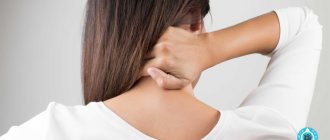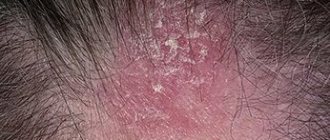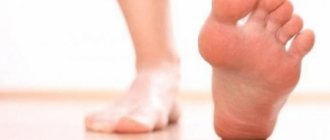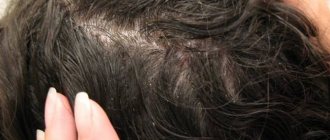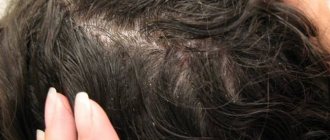Signs of skin burn after hair coloring
You can distinguish a skin burn after unsuccessful dyeing, for example, from individual intolerance to the components of the composition, by a number of characteristic signs:
- redness;
- itching – varying degrees of intensity;
- burning;
- formation of blisters - immediately after a burn or after some time;
- swelling in the temporal area of the face and cheekbones;
- local hair loss;
- temperature increase;
- weakness;
- fever, chills;
- labored breathing;
- increased heart rate;
- nausea;
- vomit;
- dyspnea;
- increased blood pressure.
Composition and effect of hair dye
The bulk of coloring agents are chemical elements. They include:
- hydrogen peroxide - it is responsible for the oxidation reaction. Depending on the concentration of the component, the degree of effect on the hair differs. The minimum peroxide content is no more than 2%, which does not cause significant harm to the bulbs. A maximum concentration of 12% can cause irreparable harm to the hair structure;
- Ammonia is an aggressive and toxic substance that causes the unpleasant odor that comes from most paints. With frequent use, it makes hair weak and brittle;
- Oxidation pigment is what gives the hair the desired shade. If dyed incorrectly, it causes hair loss.
Composition of ammonia-free products:
- monoethanolamine - a component that replaces ammonia. It causes less damage to the hair, while the effect of the pigment is several times weaker, which does not always allow one to obtain the desired result;
- plant extracts;
- vitamins;
- oils;
- organics - honey, herbs, spices, berries.
Important! Do not mix ammonia-free paints with permanent ones.
Prevention measures
Experts give the following recommendations for safe hair coloring:
- do not mix paint components in metal containers;
- the paint is prepared before the procedure; storage of the composition is unacceptable;
- choose only proven formulations that have been tested by dermatologists;
- try to use paint with a minimum content of harmful chemical components;
- When purchasing, look at the expiration dates;
- If possible, use natural dyes, such as henna.
Advice! After each use of coloring compositions, use medicinal masks, rinses, and herbal decoctions.
Causes of scalp burns from hair dye
The most common cause of scalp burns after coloring is exceeding the application time of the chemical composition. The product must not be overexposed; all stages of the procedure must comply with the attached instructions.
The epidermis is damaged and begins to deteriorate from prolonged exposure to alkaline components, peroxide, and ammonia. All of these substances individually can lead to severe injuries, but together they become an aggressive compound that requires increased attention and care when used.
Such reactions, as a rule, occur at home, when a person carries out the procedure on his own, using not the most expensive and high-quality product from the store.
In salons, hairdressers use professional dyes, which are much safer in composition and have a gentler effect on the skin and hair. In addition, when conducting a session under the supervision of a master, the risk of getting such negative consequences as allergies and burns is minimal. And even if they occur, there is a person nearby who can provide proper first aid.
Symptoms
A burn to the scalp after dyeing appears immediately. Its main symptoms are:
- pain, burning;
- severe redness;
- local increase in temperature;
- the formation of blisters filled with watery contents;
- the appearance of wounds, ulcers, erosions.
Depending on the depth of damage to the scalp, there are 3 degrees of chemical burns from paint.
- Superficial damage, accompanied by slight pain, burning, redness of the skin, itching and peeling.
- Involvement of deeper structures in pathological processes, manifested by cracking and peeling of the skin, the formation of wounds and blisters with watery liquid. Local symptoms may be supplemented by general manifestations of intoxication: headache, nausea, malaise.
- The spread of damage to all layers of the epidermis and dermis, characterized by severe pain, the formation of large blisters filled with bloody contents, and open oozing wounds on the skin.
In the classification of chemical burns, there is also a 4th degree of damage, in which the damage affects not only the skin, but also the subcutaneous tissue, muscle and nerve fibers. But it is virtually impossible to get a 4th degree burn from hair dye.
Differences from allergies
In addition to burns, the coloring composition can provoke an allergic reaction. With an allergy, unlike a burn, the integrity of the skin is not compromised. There is only redness of the skin, swelling, itching, peeling, and rash. General signs of allergies may also develop: nasal congestion and difficulty breathing, sneezing, watery eyes.
An allergic reaction can occur immediately or within 2 days after hair coloring. To prevent allergies from being complicated by eczema or hives, it is better to consult an allergist or dermatologist if alarming symptoms appear. The most severe manifestations of allergies requiring emergency medical care are angioedema and anaphylactic shock.
How to prevent skin damage when dyeing
If you dye at home, there is a risk of skin damage. To eliminate negative consequences from the procedure, use the recommendations of professional stylists and hairdressers:
- trust only high-quality products - do not buy cheap and dubious brands. Give preference to professional lines for hair coloring and care;
- carefully read the composition - the fewer active chemical components, the better;
- do not increase the exposure time of the paint - keep the composition for as long as indicated on the package. Follow all manufacturer's recommendations;
- Conduct testing before starting the procedure. Even a high-quality composition may not suit you and cause allergies. Dab some paint onto the crook of your elbow. Look at the reaction. Signs of an allergy – redness, swelling, itching. If even one of these symptoms appears, do not use the composition on your hair;
- At least 24 hours must pass from the last wash to painting. This time is enough for the body to produce subcutaneous fat - a natural protective barrier. It minimizes the negative effects of the product on the hair and scalp.
After you wash off the paint, use skincare cosmetics - make a nourishing mask, apply a restoring balm. To avoid skin irritation, rinse your head with an infusion of medicinal chamomile, brewed in the proportion: a tablespoon per liter of boiling water. Keep in mind that chamomile can turn yellow on bleached hair.
What to do if you burn your scalp with hair dye
Paint burns are not a common occurrence, but no one is immune from them. Therefore, before you change your image yourself, you need to familiarize yourself with the rules of urgent assistance:
- The first step is to remove the composition from the head. You should rinse it well for 20-30 minutes with running cool, but not cold or hot water . This way the skin will be completely cooled and cleansed of irritants.
- If there is a strong burning sensation after washing off the paint, you can apply a cool compress wrapped in film to your head to prevent the fabric from sticking.
- Panthenol should be applied to the skin in the form of a spray.
- As a pain reliever, before the doctor arrives, you can take a tablet of Analgin, Dolaren, Nise or another drug with a similar effect.
- Seek medical help immediately.
If the reaction is still caused by hypersensitivity and attacks of itching, swelling or suffocation begin, you should urgently take an antihistamine, for example, Loratadine, Suprastin, Zilola, Tavegil, Eden.
After treatment of the scalp, you may need a course of hair restoration, which is prescribed by a trichologist.
Olazol
To restore the scalp, another pharmaceutical product is used - Olazol ointment. It should be applied based on the following rules:
- It is necessary to wash the skin and dry it;
- Then the ointment is applied in an even layer to the skin;
- Procedures need to be performed 1-4 times a day;
- Shake the product before use.
Post-burn therapy
Treatment of chemical exposure may include both classical medications and folk remedies. It all depends on the severity of the burn.
Traditional treatment
The first and most necessary medications are those containing dexpanthenol, a B vitamin, a derivative of pantothenic acid. Such means include:
- cream and spray Panthenol,
- Bepanten cream,
- Pantestin ointment and cream.
They have anti-inflammatory, healing, cooling and antiseptic properties. The products help restore damaged tissues, prevent the penetration of pathogenic microorganisms, moisturize and nourish skin cells. Dexpanthenol is absolutely safe and hypoallergenic .
The following drugs have a similar effect:
- spray Olazol,
- Solcoseryl ointment,
- ointment Radevit.
These agents stimulate tissue regeneration, accelerating the process of division of healthy cells, activate local metabolism, disinfect damaged areas, and eliminate inflammation.
In addition to these ointments, solutions of Furacilin or Chlorhexidine are used to treat the consequences of a chemical burn. Bandages soaked in one of them are applied to the affected area in case of formation of cracks, wounds, ulcers, or diaper rash.
To eliminate possible allergic manifestations, the doctor prescribes antihistamines. They help relieve swelling, redness, and itching that appears as the skin heals. In extreme cases, surgery may be necessary to remove dead tissue.
Panthenol
An effective medicine is Panthenol ointment. The medicine has the following functions:
- Anti-inflammatory;
- Healing;
- Restorative;
- Antiseptic;
- Nutritious.
The ointment is applied to damaged areas of the scalp 2-3 times a day.
Before this, the skin should be washed and dried. The product can be applied in a thick layer. After just a few procedures, pain decreases and the skin is restored. Panthenol ointment is a safe product, but due to the high concentration of dexpanthenol, allergies may occur. Therefore, you must first read the instructions. Another effective remedy is D-panthenol ointment or cream.
Risk of burns when dyeing hair
The consequences of an unsuccessful staining procedure depend on the degree of damage. For minor thermal or chemical burns, skin and hair can be restored with topical medications and anti-inflammatory drugs.
Mesotherapy and skin care procedures aimed at cleansing, exfoliating, and nourishing the skin are used as additional self-help.
For more serious damage, when the hair follicles are affected, their partial restoration is possible after a course of drug therapy prescribed by a trichologist.
Treatment of itchy scalp in adults and children
Treatment should begin with a detailed diagnosis. Based on the results of studies - laboratory tests, trichoscopy, phototrichogram - the patient will be prescribed local therapy (shampoos, ointments, lotions, etc.), medications, hormones, vitamins, microelements - in each case, the treatment plan will be personalized specifically for a specific person. Some ailments, such as parasitic infections, can be cured fairly quickly. Some, for example, skin diseases, require more multi-stage and lengthy treatment.
MIGUNOVA ANASTASIA ANDREEVNA
Cosmetologist
Initial consultation: RUB 4,500
Make an appointment with a doctor Instagram
VYATKINA IRINA SERGEEVNA
Gynecologist-endocrinologist
Initial consultation: RUB 9,500
Make an appointment with a doctor Instagram
KALININA EKATERINA ALEXANDROVNA
Cosmetologist
Initial consultation: RUB 4,500
Make an appointment with a doctor Instagram
KOZLOVA EKATERINA NIKOLAEVNA
Gynecologist-endocrinologist, oncologist
Initial consultation: RUB 6,000
Make an appointment with a doctor Instagram
OZTURK IZEL ALIEVNA
Cosmetologist
Initial consultation: RUB 4,500
Make an appointment with a doctor Instagram
How to restore your scalp after an unsuccessful dye attempt
If a burn does occur, take emergency self-help measures - they relieve discomfort, eliminate dryness, and reduce inflammation:
- prepare a healing mask - take two eggs, separate the yolks from the whites. Beat the yolks until smooth. Add a little balm and rub into the root area of your head. Wrap in plastic, wrap in a towel. Leave for 10-15 minutes, rinse off the mixture with warm water;
- Rub coconut or burdock oil into damaged skin.
Each time you wash your hair, use exfoliating scrubs. They will remove dead epithelial cells and start the processes of natural hair regeneration. Please note that scrubs can be used only after the symptoms of skin damage have completely disappeared.
After an unsuccessful dyeing attempt, a light massage is helpful. Buy a gentle shampoo based on soap root. As an option, wash your hair with baby shampoo - it does not cause irritation and has a softening effect on the skin.
The principle of restoring minor damage comes down to normalizing the water-salt balance and nourishing the hair with vitamin complexes - both locally and orally.
Traditional methods
It is possible to treat a burn using traditional recipes only in case of minor injury without the formation of blisters and open wounds. Otherwise, the likelihood of getting an infection and aggravating the situation increases significantly.
Decoctions are used to heal the skin, and masks and oil compresses are used to restore hair health.
- Mix 2 tablespoons of St. John's wort and chamomile, pour a liter of boiling water and leave for about an hour. After cooling, strain the product and rinse your hair to relieve itching, inflammation and improve the appearance of your hair. The infusion can be used daily.
- In the same way, a mixture of string, mint and yarrow or sage, nettle and plantain is used. All herbs from the first or second collection are taken in equal proportions, pour 2 liters of water into 4 tablespoons of the collection and bring to a boil. The broth is cooled and diluted with another 2 liters of liquid. It will soothe the skin, soften it, speed up healing and strengthen the hair.
- Mix 3 tablespoons of pumpkin oil and 5 tablespoons of aloe juice. Apply the mixture to the scalp, rub in lightly with your fingertips if possible and leave for 30 minutes. Rinse with warm running water and hypoallergenic baby shampoo. Oil products are not recommended for use on open wounds and blisters. Their use is much more important during the healing stage of injuries.
- A mask of 2 tablespoons of almond oil mixed with 1 tablespoon of chamomile oil and 1 yolk is good for hair restoration. The mixture is slightly heated in a water bath to 37-38 degrees and evenly distributed over the strands. After half an hour, wash off the mask with warm running water.
When treating chemical burns, it is not recommended to use fermented milk products or citrus juices. Damaged skin may suffer even more from additional exposure to acids.
Essential oils, honey, decoctions of potent herbs (celandine, wormwood, hops), and the pulp of various fruits are also contraindicated. These products and plants can provoke new irritation, redness and inflammation of the still fragile epidermis, and intensive leaching of thick compounds can damage the healing surface.
Precautionary measures
Any injury is easier to prevent than to cure. To prevent your scalp from being burned by hair dye, you must adhere to the following rules:
- Do not purchase products from unfamiliar manufacturers, pay attention to the integrity of the packaging, expiration dates, and do not save by choosing the cheapest option - you can pay for this with your health.
- Do not buy paint on the market where it is not protected from weather conditions, exposure to the sun or frost.
- Follow the instructions for preparing the composition, its application and do not increase the exposure time.
- You cannot mix the components in an iron container, as they may react with the metal, which will affect the composition of the product.
- It is forbidden to store the prepared mass: after preparation it must be used immediately . Chemical compounds in air quickly oxidize, which affects the quality of the paint.
- The composition is applied exclusively to the hair growth area. The surrounding skin should be protected with a rich cream or any vegetable oil.
- Before applying paint, be sure to test for an allergic reaction on a small area and observe the skin reaction. If no signs of irritation appear, staining can be done.
- It is better to use natural dyes (basma, henna, onion peel, chamomile decoction), ammonia-free formulations, as well as those that do not contain hydrogen peroxide. Gentle products are less durable, but safer for the health of skin, hair and people in general.
How to avoid burns while dyeing
If the manufacturer of an expensive and popular brand promises that its paint is absolutely harmless, do not believe it. All dyes have a negative effect on the skin and hair. To make coloring safe and minimize the risk of burns, experts suggest using the following life hacks:
- panthenol - apply the spray before starting the procedure - it will not interfere with the dye working with your hair;
- aloe gel is a neutral product, absorbs quickly, protects well, does not weigh down or make the root zone of the hair greasy;
- professional products - serums, protectors, lotions - have a liquid consistency and are quickly applied. They are used both before and during dyeing. Such compositions are produced by many manufacturers specializing in high-quality cosmetics.
